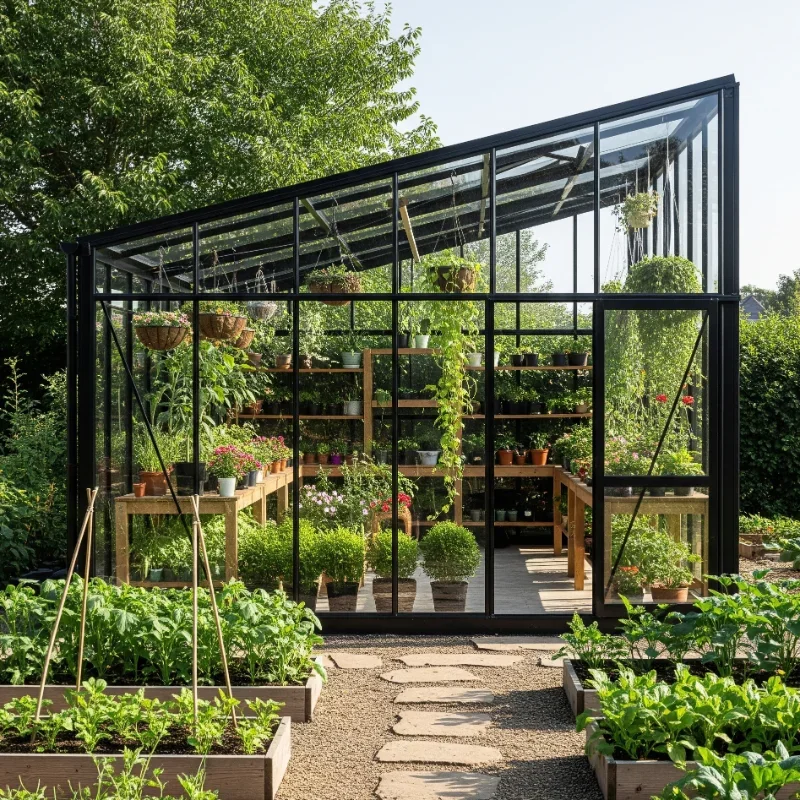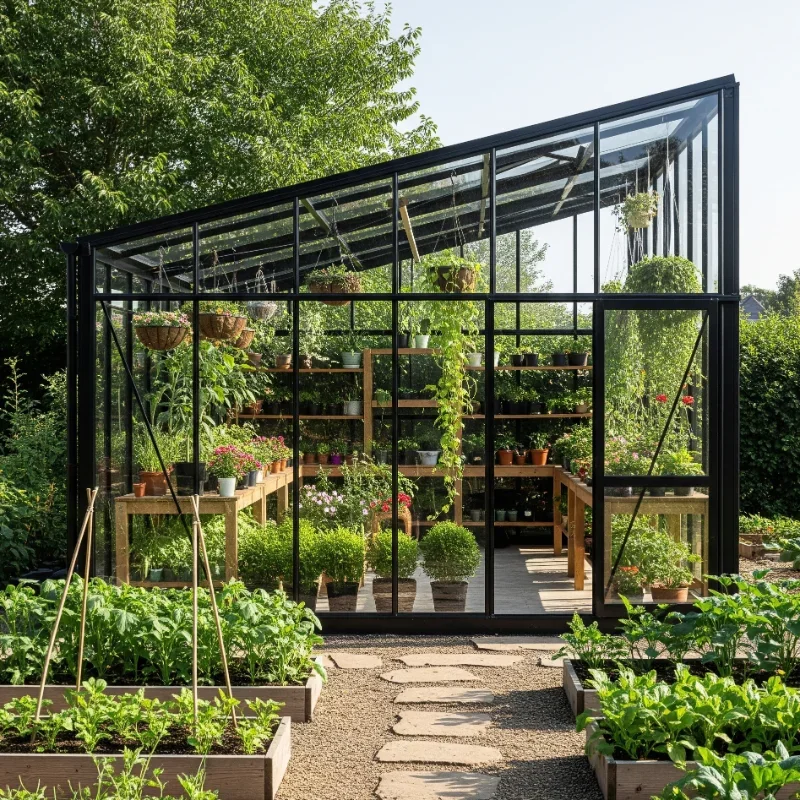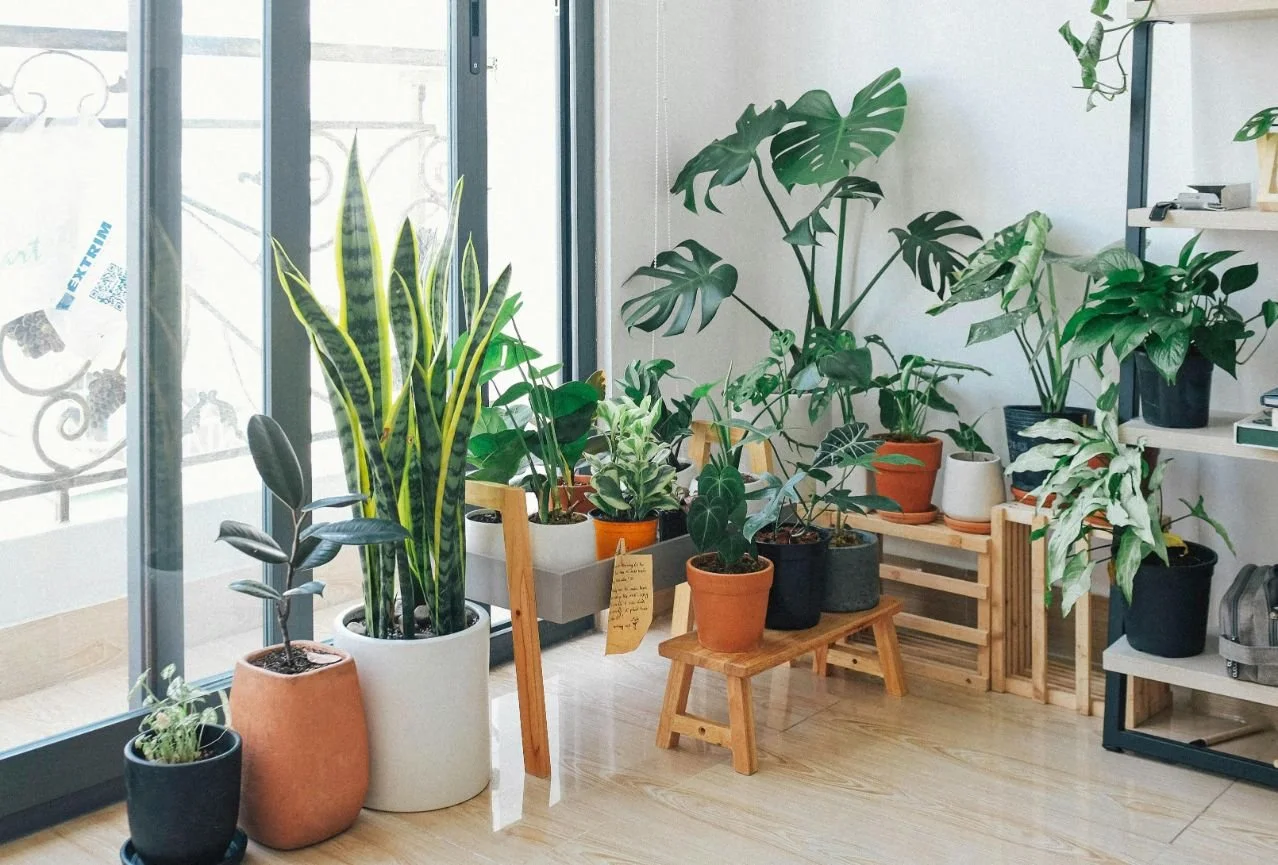15 Green House Ideas for Lush, Eco-Friendly Living
Create your perfect eco-friendly greenhouse! Discover 15 innovative ideas from solar designs to aquaponics systems for sustainable living.
Ever dreamed of picking fresh tomatoes in January or growing tropical plants in Minnesota? Welcome to the wonderful world of greenhouses, where seasons bend to your will and sustainable living blooms year-round! Whether you're a seasoned gardener tired of frost ruining your harvest or an eco-warrior looking to shrink that carbon footprint, a greenhouse isn't just a structure; it's a gateway to self-sufficiency. Picture this: stepping into your own glass paradise on a snowy morning, breathing in the earthy scent of thriving plants, and knowing you're living lighter on the Earth. From high-tech solar-powered systems to charming DIY solutions that won't break the bank, modern greenhouses have evolved far beyond your grandma's glass box. Ready to discover how the right greenhouse can revolutionize your relationship with food, nature, and sustainable living? Let's explore 15 innovative ideas that'll turn your green thumb even greener!
1. Solar-Powered Greenhouse Systems
Harness the sun's power twice: once for your plants and again for your greenhouse operations! Solar panels mounted on south-facing roofs or nearby structures can power everything from ventilation fans to automated watering systems. Modern solar setups include battery storage, ensuring your greenhouse stays operational even during cloudy days. Consider flexible solar panels that integrate seamlessly with curved greenhouse roofs. The initial investment pays off through eliminated electricity bills and potential grid feed-in tariffs. Smart inverters can prioritize power usage, running essential systems first. Many greenhouse gardeners start small with solar-powered vent openers and gradually expand their systems. Position panels to avoid shading growing areas while maximizing sun exposure. Include monitoring apps that track energy production and consumption. This sustainable approach reduces operating costs while demonstrating environmental commitment. Your greenhouse becomes a living example of renewable energy in action!
2. Recycled Material Greenhouse Construction
Why buy new when you can build green with reclaimed treasures? Old windows become charming greenhouse walls, while salvaged lumber frames your eco-friendly structure. Plastic bottles filled with water create insulating walls that regulate temperature naturally. Reclaimed doors make perfect entrances with built-in character. Source materials from demolition sites, architectural salvage yards, or online marketplaces. Shipping pallets transform into sturdy staging and shelving. Even old trampolines can become unique dome frames! Mix materials creatively: combine vintage windows with corrugated metal for rustic industrial appeal. The key lies in proper sealing and structural integrity. Document your building process to inspire others and create a conversation piece. Each recycled element tells a story while keeping materials from landfills. This approach slashes construction costs while creating a one-of-a-kind growing space that reflects your values.
3. Aquaponics Integration Design
Combine fish farming with vegetable growing in a symbiotic system that mimics nature's cycles! Fish waste provides nutrients for plants, while plants filter water for fish. Design your greenhouse with raised grow beds above fish tanks, creating vertical efficiency. Tilapia, catfish, or ornamental koi work well in these systems. Choose plants that thrive in nutrient-rich water: lettuce, herbs, and tomatoes excel. Include biofilters with beneficial bacteria that convert ammonia to plant-friendly nitrates. Automated pumps circulate water between components. This closed-loop system uses 90% less water than traditional gardening. Monitor pH levels and temperature for both fish and plant health. Add backup aeration to protect fish during power outages. The result? Fresh fish and vegetables from the same square footage. Your greenhouse becomes a miniature ecosystem producing protein and produce sustainably!
4. Living Wall Greenhouse Features
Transform vertical surfaces into productive gardens that maximize space and beauty! Living walls use hydroponic or soil-based systems to grow plants vertically. Install modular pocket planters or trellis systems on greenhouse walls. These green walls improve air quality, provide additional insulation, and create stunning visual displays. Grow trailing plants like strawberries, compact vegetables, or cascading herbs. Automated drip irrigation ensures even water distribution. Choose plants based on light exposure at different wall heights. Living walls also moderate temperature extremes and increase humidity naturally. Include accessibility features like pulleys for rotating planters. Mix edibles with ornamentals for year-round interest. Moss walls require minimal maintenance while providing acoustic dampening. This vertical approach can triple your growing space without expanding your greenhouse footprint. It's like having a salad bar growing on your walls!
5. Rainwater Harvesting Systems
Capture nature's irrigation system with smart rainwater collection that makes every drop count! Install gutters along greenhouse edges directing water to storage tanks. Calculate roof area to estimate collection potential: 1,000 square feet can harvest 600 gallons from one inch of rain. Use first-flush diverters to eliminate initial dirty runoff. Position tanks elevated for gravity-fed irrigation or include pumps for pressurized systems. Dark-colored tanks prevent algae growth while clear tanks let you monitor levels. Add mosquito screens and tight-fitting lids for safety. Connect multiple tanks with overflow pipes for maximum storage. Include filters for drip irrigation systems. This free water source reduces utility bills and provides plants with naturally soft water. During droughts, you'll appreciate this backup supply. Paint tanks to match your greenhouse aesthetic or hide them with climbing plants. Water independence never looked so good!
6. Geodesic Dome Greenhouses
Step into the future with geodesic domes that maximize strength while minimizing materials! These spherical structures distribute weight evenly, withstanding heavy snow and strong winds. The dome shape provides excellent light distribution and natural air circulation. Build frames from wood, metal, or PVC pipe connected at calculated angles. Cover with polycarbonate panels or greenhouse plastic. Interior space feels surprisingly roomy despite the compact footprint. The unique architecture creates multiple microclimates for diverse plants. Central peaks accommodate tall plants while edges suit ground covers. Add opening panels or doors for ventilation. These eye-catching structures become landscape focal points. Kits simplify construction for DIY enthusiasts. The geometric design appeals to modern aesthetics while providing practical benefits. Your dome greenhouse looks like it landed from another planet while functioning beautifully on Earth!
7. Underground Pit Greenhouses
Dig into Earth's natural insulation with pit greenhouses that maintain stable temperatures year-round! Also called walipinis, these structures use soil's thermal mass to moderate extremes. Excavate 6-8 feet deep, angle the roof toward winter sun. Underground walls stay around 50°F regardless of surface temperatures. This design requires proper drainage and waterproofing. Include steps or ramps for access. The sunken design protects against wind while capturing maximum sunlight. Perfect for cold climates where traditional greenhouses require excessive heating. Add thermal mass like water barrels or rock walls for additional temperature stability. Ventilation prevents humidity buildup. These greenhouses extend growing seasons dramatically with minimal energy input. The earth-sheltered design blends into landscapes beautifully. Construction costs more initially but saves heating expenses forever. You're essentially gardening in nature's root cellar with a sunny roof!
8. Smart Climate Control Technology
Welcome to the age of intelligent greenhouses where apps control your growing environment! Smart sensors monitor temperature, humidity, soil moisture, and light levels continuously. Automated systems respond by opening vents, activating fans, or triggering irrigation. WiFi-enabled devices send alerts to your phone about environmental changes. Program different zones for various plant needs. Machine learning algorithms optimize conditions based on plant responses. Include backup manual controls for tech failures. Solar-powered sensors eliminate wiring hassles. Data logging helps identify patterns and improve future growing. Voice assistants can provide updates and accept commands. Smart plugs control heaters and fans remotely. Integration with weather forecasts allows preemptive adjustments. This technology transforms greenhouse management from guesswork to precision. Even vacation becomes stress-free knowing your plants receive perfect care. The future of gardening fits in your pocket!
9. Vertical Growing Systems
Multiply your growing space by thinking up instead of out! Vertical systems include tower gardens, hanging planters, and tiered shelving. Hydroponic towers grow dozens of plants in minimal floor space. A-frame structures provide two growing surfaces while allowing light penetration. Rotating gardens ensure equal sun exposure for all plants. Use lightweight materials to prevent structural strain. Incorporate pulleys or hydraulics for easy access to high plants. LED grow lights supplement natural light in shaded areas. This approach works especially well for strawberries, lettuce, and herbs. Design modular systems that adjust as plants grow. Include drip irrigation running from top to bottom. Vertical growing improves air circulation, reducing disease problems. Small greenhouses can produce commercial quantities using vertical techniques. It's like creating a plant skyscraper in your backyard!
10. Companion Planting Layouts
Design your greenhouse like nature's neighborhood where plants help each other thrive! Tomatoes love basil neighbors who repel pests and improve flavor. Marigolds scattered throughout deter aphids and whiteflies. Tall plants provide shade for lettuce during hot summers. Nitrogen-fixing beans enrich soil for heavy feeders. Plan layouts considering height, spread, and mutual benefits. Create guilds of plants that work together: corn, beans, and squash form the classic "three sisters." Include flowers to attract beneficial insects. Aromatic herbs confuse pests searching for target crops. This approach reduces pesticide needs while maximizing productivity. Design pathways allowing access without disrupting companion relationships. Rotate companion groups seasonally to prevent soil depletion. Document successful combinations for future planning. Your greenhouse becomes a balanced ecosystem where diversity creates resilience. It's permaculture principles under glass!
11. Natural Pest Management Solutions
Keep your greenhouse pest-free without toxic chemicals using nature's own defense systems! Introduce beneficial insects like ladybugs for aphid control and lacewings for various pests. Hang yellow sticky traps to monitor and catch flying insects. Plant pest-repelling herbs around greenhouse perimeters. Neem oil sprays handle outbreaks organically. Physical barriers like row covers protect vulnerable seedlings. Maintain proper air circulation to prevent fungal issues. Companion planting confuses and deters pests naturally. Regular inspection catches problems early before they explode. Remove infected plants promptly to prevent spread. Encourage spiders and ground beetles as natural predators. Use diatomaceous earth for crawling insects. Proper sanitation eliminates pest hiding spots. This integrated approach creates a balanced environment where pests never dominate. Your vegetables remain chemical-free while your conscience stays clear. Nature's pharmacy provides all the medicine your plants need!
12. Composting Integration Systems
Transform waste into black gold right inside your greenhouse! Design includes space for compost bins that benefit from greenhouse warmth, accelerating decomposition. Three-bin systems allow continuous composting cycles. Worm bins under benches create rich vermicompost while processing kitchen scraps. Compost tea brewers provide liquid fertilizer for foliar feeding. Position bins for easy access but away from eating areas. Include carbon storage for browns: shredded paper, dry leaves. Thermophilic composting kills pathogens and weed seeds. Finished compost enriches greenhouse beds continuously. This closed-loop system eliminates fertilizer costs. Bokashi fermentation handles meat and dairy scraps other systems can't. Monitor moisture and temperature for optimal decomposition. Screened lids prevent pest problems. Your greenhouse becomes a nutrient recycling center. Plants thrive on homemade compost while landfills receive less waste. It's sustainability in action!
13. Seasonal Thermal Mass Storage
Harness the sun's daytime energy to warm nights naturally using thermal mass! Water barrels painted black absorb heat during sunny days, releasing it slowly overnight. Stack concrete blocks or bricks along north walls for additional heat storage. Rock beds under raised planters moderate soil temperatures. Position thermal mass where it receives direct winter sunlight. Calculate mass needed based on greenhouse volume and climate. Phase-change materials offer cutting-edge heat storage in smaller spaces. Combine thermal mass with insulation for maximum efficiency. Paint barrels decoratively or grow vines to disguise utilitarian appearance. This passive heating reduces or eliminates supplemental heating needs. Summer shading prevents overheating thermal mass. Include thermometers to monitor effectiveness. Traditional greenhouses used this principle; modern materials improve efficiency. Your greenhouse maintains comfortable temperatures using physics, not fuel!
14. Multi-Purpose Greenhouse Spaces
Design greenhouses that nurture both plants and people! Include seating areas for morning coffee surrounded by growing abundance. Workshop benches provide space for potting and propagation. Reading nooks offer peaceful retreat during winter months. Yoga practitioners love greenhouse morning sessions. Artists find inspiration among plants. Design flexible spaces that transform seasonally: summer tomato jungle becomes winter relaxation zone. Include electrical outlets for various activities. Proper ventilation ensures comfort during all uses. Non-slip flooring prevents accidents. Storage solutions keep tools accessible but tidy. Some add small refrigerators for fresh-picked storage. Speakers provide music for plants and people. This approach maximizes investment by creating year-round useful space. Your greenhouse becomes a living room, literally! Friends gather where food grows, connecting with nature while socializing.
15. Community Greenhouse Models
Share the growing joy through community greenhouse initiatives! Neighborhood groups pool resources for larger, better-equipped structures. Divide space into individual plots or manage collectively. Schools integrate greenhouses into curriculum, teaching sustainability hands-on. Community gardens add greenhouses for year-round production. Membership fees cover maintenance and utilities. Organize workshops sharing knowledge between experienced and novice gardeners. Tool libraries reduce individual equipment costs. Communal composting systems handle neighborhood organic waste. Social events like potlucks strengthen community bonds. Elder members share traditional techniques with younger generations. Donation programs provide fresh produce to food banks. Grant funding often supports community greenhouse projects. Shared labor makes maintenance manageable. These spaces become community hubs fostering connections beyond gardening. Democracy in action as groups decide planting schedules and policies. Your neighborhood becomes more resilient and connected through shared growing!
Conclusion
These 15 greenhouse ideas prove that sustainable living isn't just a dream; it's an achievable reality! Whether you choose high-tech solutions or simple DIY approaches, each concept brings you closer to self-sufficiency and environmental harmony. Remember, the best greenhouse is one that fits your space, budget, and growing goals. Start small, dream big, and let your greenhouse evolve with your needs. Your journey toward lush, eco-friendly living begins with that first seed!
Read next: How to Create a Refreshing Green Room Aesthetic for Your Space
Frequently Asked Questions
Q1: What's the minimum size for a functional greenhouse?
A: A 6x8 foot greenhouse can grow substantial food for small families year-round effectively.
Q2: How much does a basic DIY greenhouse cost?
A: DIY greenhouses start around $500 using recycled materials and simple hoop designs.
Q3: Can greenhouses work in extremely cold climates?
A: Yes, with proper insulation, thermal mass, and design, greenhouses thrive anywhere successfully.
Q4: Do I need permits to build a greenhouse?
A: Check local codes; many areas allow small greenhouses without permits, larger need approval.
Q5: What's the best greenhouse covering material?
A: Polycarbonate offers durability and insulation; plastic works budget-friendly; glass looks beautiful traditionally.

















